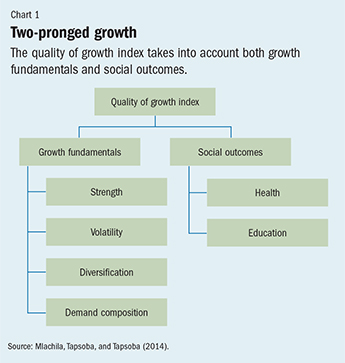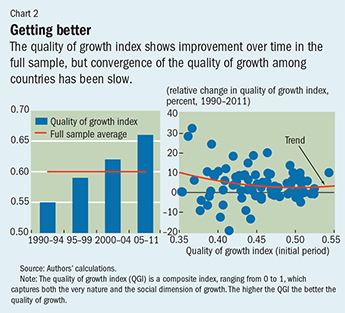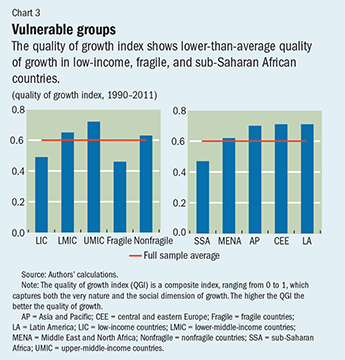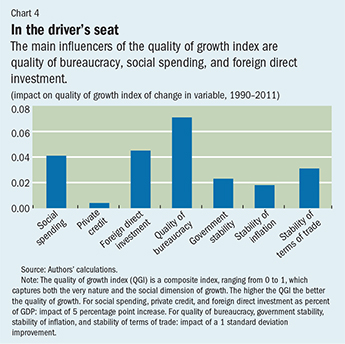FINANCE & DEVELOPMENT, June 2015, Vol. 52, No. 2
Montfort Mlachila, René Tapsoba, and Sampawende Tapsoba
High growth alone will not improve social conditions
Translating strong growth into better living conditions is the holy grail for policymakers in developing economies, many of which have experienced strong economic growth in the past decade. But poverty, inequality, and unemployment indicators remain stubbornly high in many countries. The quality of growth is as important as its level—maybe even more important. High growth alone will not improve social outcomes.?
There is increasing agreement that inclusive growth—that benefits all members of society—is an important element of so-called good growth. The common denominator of inclusive growth is its quality, which can mean different things to different people. Like beauty, quality growth is in the eye of the beholder.? Recent economic and political history has shown that high growth does not necessarily lead to better social outcomes. Likewise, good social outcomes without sound growth are unsustainable (Berg, Ostry, and Zettelmeyer, 2012). Good growth in developing economies must promote the ultimate goals of any development policy—better living standards, lower poverty, and reduced inequality.
A mushrooming literature shows that countries with high, durable, and socially friendly growth are more likely to improve living standards and reduce poverty faster (see, for example, Dollar and Kraay, 2002; Sala-i-Martin, 2006). Good growth should, therefore, ensure inclusion of segments of the population that are on the fringes of the growth process. Redistribution of the fruits of growth is less important than ensuring that growth is broad based and leads to better social outcomes.
The measure of quality
Despite consensus in the economics profession that growth alone does not lead to better social outcomes (Ianchovichina and Gable, 2012), quality growth still lacks a rigorous definition or formal quantification.
In a recent paper (Mlachila, Tapsoba, and Tapsoba, 2014), we develop a quality of growth index (QGI) that captures both the intrinsic nature of growth and its social dimension.
Our premise is that not all growth produces favorable social outcomes. How growth is generated is critical to its sustainability and ability to create decent jobs, enhance living standards, and reduce poverty. We aim in our design of the QGI to capture these multidimensional features of growth by focusing on its very nature and desired social outcomes.

The QGI is a composite index, simple and transparent in its design. The index results from the aggregation of two building blocks: the intrinsic nature of growth—its strength, stability, diversification, and outward orientation—and the social dimension, representing the desired social outputs from growth (see Chart 1).
Strong, stable, diversified, and export-oriented growth is necessary to curb poverty (Dollar and Kraay, 2002). Unstable growth worsens poverty and undermines equality because the erosion of poor people’s skills during bad times is not remedied when the economy pulls out of a crisis (Ames and others, 2001). Diversified growth reduces variability in economic performance (Papageorgiou and Spatafora, 2012), which helps reduce poverty. And export-oriented growth is more likely to raise productivity growth, including via learning-by-doing, importation of advanced technologies, transfer of knowledge, the discipline of the world market, competition, and foreign direct investment (Diao, Rattsø, and Stokke, 2006). Such outward orientation of growth can also increase a country’s vulnerability to fluctuations in the external environment, but the QGI addresses this concern to some degree by accounting for growth volatility.
In addition, a long and healthy life, along with access to a good education, is an important and well-accepted indicator of poverty reduction (Sen, 2003). The QGI omits other key variables of inclusiveness, such as employment, inequality, and environmental factors, because of data limitations. The index ranges from 0 to 1—with 1 as the highest score for good growth—and covers more than 90 developing economies during 1990–2011.
What is new about the index? Is it just a rehash of the well-known Human Development Index (HDI) developed by the United Nations (UNDP, 1990) or of other welfare indicators? Not at all: there are notable differences.
The QGI goes beyond income levels and focuses on the very nature of growth. The HDI is mostly income based, building as it does on the level of income per capita in a given year. It can be argued that the HDI actually represents millennia of accumulated growth—the level of income at a given date is the sum of growth episodes. The advantage of the QGI is its ability to assess the quality of specific episodes of growth both within and across countries. This feature lets policymakers know whether their growth strategy is yielding good results. Moreover, the QGI has the ability to identify growth and social outcomes actually attributable to current or recent policies.
The QGI also differs from the recently developed Social Progress Index (SPI; Stern and others, 2014). The SPI, more than the HDI, focuses on aspects that are close to the social dimension of the QGI but doesn’t take into account the fundamental aspects of growth that are at the core of the QGI.
QGI findings
Several important themes emerge from our empirical investigation of the QGI.

The quality of growth has been improving over the past two decades (see Chart 2), thanks to the confluence of a number of factors, including global moderation of external shocks such as terms-of-trade fluctuations; the implementation of generally sound macroeconomic policies; and a gradual shift toward more socially friendly public spending. These have contributed to raising growth, reducing its volatility, improving its composition, and enhancing its potential to deliver better social outcomes. In addition, the convergence of the quality of growth among countries is relatively sluggish. The lowest performers tend to catch up to the best performers over time, but only slowly. This follows the traditional convergence hypothesis found in the growth literature. In other words, once a country’s quality of growth is high it becomes increasingly difficult to keep on improving it—just as there are biological limits to the improvement of life expectancy. Conversely, countries with low QGI tend to improve the quality of their growth at a relative faster pace. Lasting improvements in social outcomes call for sustained high-quality growth over a long time—30 to 40 years. Countries such as China and Malaysia have made great strides on this front, though social safety nets have yet to be fully developed. A number of African countries, such as Tanzania and Zambia, have achieved notable improvements in the quality of growth, but they must sustain this momentum over time.

There are considerable cross-country variations in income levels and regions (see Chart 3). Unsurprisingly, upper-middle-income countries record the highest scores, followed by lower-middle-income countries and low-income countries. Also unsurprisingly, fragile states are faced with structural impediments to the quality of growth and generally fall behind in this area.
From a regional perspective, Latin America, central and eastern Europe, and Asia and the Pacific stand out as the best QGI performers, mostly because of significant improvement in the index’s social component. Latin America started from a weak base, suffering from high poverty and income inequality in the early 1990s, and the performance of central and eastern Europe on the QGI was boosted by strong social advances after the transition to market economies in that region. Strong, mostly export-oriented growth that brought substantial productivity gains through technology and innovation transfers was the main driver in Asia and the Pacific. These trailblazers are followed by the Middle East and North Africa region, which is helped by an improvement in the social dimension, coupled with relatively strong growth. Sub-Saharan African countries rank at the bottom despite their recent robust growth, which has yet to translate into better social outcomes.

Empirical models indicate that there is considerable scope for policymakers to improve the quality of growth (see Chart 4) by improving macroeconomic and political stability, institutional quality, pro-poor public spending, and financial development. And a more favorable external environment certainly also helps.
Increased public resources for social sectors such as health and education help strengthen human capital, which not only raises productivity of the economy as a whole, but also opens the door to equal opportunity for individuals to reap the fruits of higher growth. Greater financial development, which eases access to credit, helps unleash the private sector’s potential for creating wealth and good jobs. And external conditions, especially foreign direct investment, fill domestic savings shortfalls for domestic investment and accelerate the transfer of technology and knowledge.
Room for improvement
Even though the QGI contributes to the ongoing analysis of unequal growth, there are ways to improve the index. It has potential as a timely and cost-effective tool for policymakers to monitor the progress of inclusive growth. But, like all indices, it is only as good as the underlying data. The quality of social data is particularly weak and patchy, so we were forced to make a number of interpolations and use five-year averages in our calculations. The index could be enhanced by including measures of inequality as well as labor market variables.
Last but not least, a word of caution: the QGI does not address long-term sustainability. Simply put, the index cannot predict whether a country’s current policies—which may improve the quality of growth today—will lead to economic or environmental disaster in the long run. For instance, a country may improve its quality of growth by rapidly depleting its natural resources or running up public debt.
The QGI is a useful tool in the quest for better measurement of the quality of growth and could help guide a strategy for successful growth in the developing world. ■